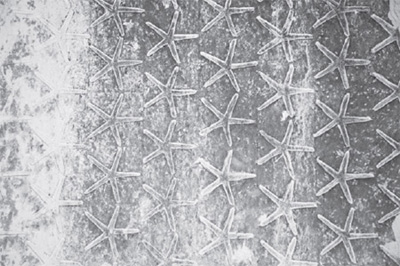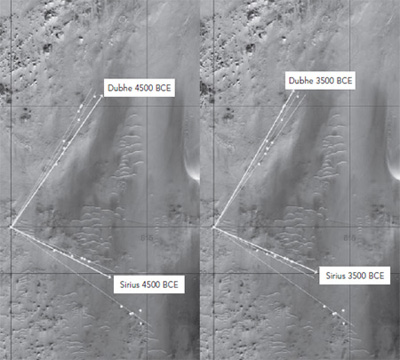Black Genesis (15 page)


Figure 4.9. Left, the Sirius plus Alkaid alignment ca. 6100 BCE; right, the Orion stars and Vega depicted at one date ca. 6270 BCE. From that epoch, the Orion stars all move through vernal equinox heliacal risings, as the Vega rising line moves southeast over the megalith alignments.
Another association with the date of 6100 BCE is that the rising of the bright circumpolar star Vega was in line with the A2 megaliths as Orion's belt began rising over the C1 line.
*20

Figure 4.10. The star-studded ceiling in Tepi I pyramid at Saqqara (Sixth Dynasty)
In summary, at Nabta Playa in 4500 BCE and 3500 BCE there were megalith alignments (B1 and B2) oriented to the rising of Sirius that ran eastward (as suggested by Malville and his coauthors in 2007), and we have shown that these alignments were used simultaneously withâand formed right angles withâmegalith alignments (A1 and A3) to the star Dubhe, which ran northward. It also seems that in 6100 BCE megalith alignment C1 was directed to the rising of Sirius, which was used simultaneously with the star Alkaid in the north. In addition, in 6200 BCE line C1 may also have been associated with the heleical rising of Orion's belt at the spring (vernal) equinox. We have seen that these Orion's-belt alignments for C1 were consistent with the use of this stellar asterism in the Calendar Circle at that same epoch. It seems, then, that the C1 megaliths were either off the playa and thus not affected by the heavy playa sedimentation period or were remnants of much earlier ceremonial structures (as was Complex Structure A).
*21
These findings and conclusions are perhaps better visualized in the table format below.
| MEGALITH ALIGNMENTS AT NABTA PLAYA | |||
| MEGALITH LINE | MALVILLE AND WENDORF ET AL (2007) | OUR MEASUREMENTS (2005) | ASSOCIATION |
| A1 | 30.6 degrees | 30.00 degrees | Dubhe simultaneous to Sirius rising ca. 4500 BCE |
| A2 | 28.1 degrees | 27.68 degrees | Alkaid simultaneous to Sirius rising ca. 6100 BCE; also, Vega ca. 5840 BCE autumnal equinox heliacal rising; also, Dubhe simultaneous with Sirius rising ca. 4000 BCE |
| A3 | 26.3 degrees | 25.86 degrees | Dubhe simultaneous to Sirius rising ca. 3500 BCE |
| B1 | 120.1 degrees | 121.11 degrees | Sirius rising ca. 4500 BCE, with Dubhe at line A1 |
| B2 | 116.6 degrees | 117.49 degrees | Sirius rising circa 3500 BCE, with Dubhe at line A3 |
| C1 | 125.4 degrees (2001) | 130.1 degrees | Sirius rising ca. 6100 BCE, with Alkaid at line A2; also, Orion's belt at vernal equinox heliacal rising ca. same epoch |
We can see from this table that the megalithic alignments at Nabta Playa represent a coherent and consistent ensemble that has meaning when it is deciphered with astronomy. Clearly the alignments, instead of being random, are carefully made to target the rising of stars that were important ritualistically and also practically to the ancient people of Nabta Playa. The anthropologists of the CPE as well as other archaeoastronomers who have carefully studied this site are all in agreement: Nabta Playa was an important ceremonial center that required considerable complex social organization, physical effort, and resources to construct and maintain over a long period of time. It thus is sensible to conclude that embodied in the design of the ceremonial complex is some very high meaning that can be read with astronomy. As we will see later this system of knowledgeâwe can perhaps call it star knowledgeâat Nabta Playa was carried forward in time and space to the pharaonic civilization of the Nile Valley. Meanwhile we'll take an initial look at a well-known star ritual from ancient Egypt that shows how and why Sirius and a star in the Big Dipper, Dubhe, were used simultaneously to align sacred megalithic monuments from earliest times harking back to 3200 BCE and perhaps even earlier . . . just as they were used at Nabta Playa.
A RIGHT ANGLE AND TWO STARS
The simultaneous observation of Sirius rising in the east and a star of the Big Dipper in the northern sky is a strong, nontangible piece of evidence that shows a direct link between the prehistory of the Sahara and the archaic period of ancient Egypt and the great civilization that ensued from it. At one end of this link is the ceremonial complex of Nabta Playa and at the other end is the earliest ceremonial complex in the Nile Valley on the Island of Elephantine near Aswan. In chapter 6 we will look directly at this link, but for now we will look at an important early Egyptian ritual known as
stretching the cord,
because it is likely that in this lies the very source of why and how the simultaneous observation of two stars was used by the Egyptians and, earlier, by the people of Nabta Playa in association with the astronomical alignment of megalithic structures.
The ancient Egyptian texts and temple reliefs explain that stretching the cord was carried out by a priestess, who represented a deity associated with the stars, and the pharaoh. Both the priestess and pharaoh held a rod and a mallet, and a rope or cord was looped between the rods. The priestess stood with her back to the northern sky and faced the pharaoh. This scene is depicted on many temples, and the texts alongside it tell us that the pharaoh observed the trajectory of the stars with his eye in order to establish the temple in the manner of ancient times. In the texts we are unequivocally told that the king looked at a star in the Big Dipper (called Mesekhtiu, the Bull's Thigh). Some of the texts, however, mention the star Sirius and imply that it also was somehow involved in the ritual.
Exactly how was this stellar alignment ritual performed? Was the king aiming his gaze at a star in the Big Dipper while, simultaneously, the priestess announced the moment of the rising of Sirius, after which the cord between them was stretched and the rods were hammered into the soil, thus fixing the axis of the future temple? A further clue to the ritual is that the pharaoh observed carefully the motion of a star in real time. Inscriptions on the Temple of Horus at Edfu, accompanying portrayals of the ritual, quote the pharaoh: “I take the measuring cord in the company of Seshat. I consider the progressive movement of the stars. My eye is fixed on the Bull's Thigh constellation. I count off time, scrutinizing the clock . . .”
15
This is also what might have happened at the ceremonial center of Nabta Playa thousands of years earlier. An observer who was standing at Complex Structure A held a rod with a rope attached to it. Another observer, also holding a rod, stood some twenty paces north of the first observer with his or her back to the Big Dipper. This second observer then waited for Sirius to rise, and, at that precise moment, he or she gave the signal to the first observer to stretch the cord and aim it toward a star in the Big Dipper. Then, when the alignment was achieved, the first observer was to fix the rod in the soil. Later, a row of megaliths would be set along this alignment. On another day, this ritual was repeated to set an alignment toward the rising spot of Sirius on the horizon as seen from CSA. Thus the two lines of stone work together, one going north (line A) and the other southeast (line B). This interpretation is consistent with the ancient texts that describe that the Dubhe alignment required real-time observing of the star in the sky, whereas Sirius rising on the horizon is more easily set. These two lines also form a rough right angle, a feature that surely would have been noticed and intriguing.

The relation of Dubhe and Sirius
We can go back in time to approximately 9000 BCE , when the north celestial pole is near the shoulders of the constellation Hercules. Dubhe rises many hours before Sirius and is very high in the sky when Sirius rises, and Dubhe's declination is so far from north that Dubhe and the whole Bull's Thigh constellation are far from being circumpolar stars. If we turn the clock forward to around 4500 BCE , the celestial pole has moved so that it is close to the Bull's Thigh constellation, Dubhe has moved north in declination to become a circumpolar star, and Dubhe is decreasing in altitude so that it is at only 33 degrees altitude when Sirius rises, as seen at Nabta. The low altitude of Dubhe when Sirius is on the horizon means that the angular separation of the two stars in the sky is essentially preserved in the angle of their alignments on the ground.


Figure 4.11. The right-angled megalith alignments of Sirius and Dubhe at 4500 BCE and at 3500 BCE as the stars moved through precession
Indeed, any architect or designer will readily agree that right angles are universally recognized by humans not least because they define, among many other things, the four cardinal directions of Earth. Sirius rising may have been marked by the star Alkaid in the Big Dipper from the seventh millennium BCE to about 4800 BCE, but after that date and until 3500 BCE the star Dubhe in the Big Dipper replaced Alkaid, and it was noticed that Dubhe and Sirius always formed a right angle. After that date, Nabta Playa and the ceremonial complex were abandoned.
*22
